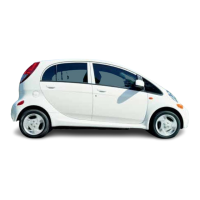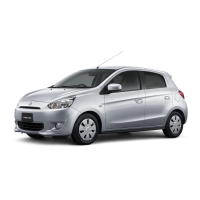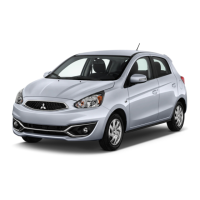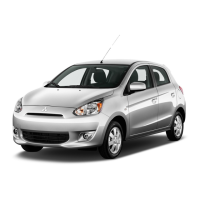Chapter 3 Cooling, heating and air conditioning systems
3-11
, EVAPORATOR
COMPRESSOR
\ /
CLUTCH
EX
13.3 A typical air conditioning system schematic
HIGH PRESSURE
14.7 Watch the receiver/drier sight glass and see if it
looks clear inside (which is normal) - if it’s foamy inside,
the system needs recharging
1988 and later moi7els
Refer to illustration 12.19
18 To remove the heater core, the heater unit must be removed from the
vehicle.
19 Working inside theenginecompartment, disconnect the heater hoses
from the heater unit(see illustration). Place rags underthe hoseconnec-
tions to catch spilled coolant. After disconnecting the hoses, plug them
and the heater unit tubes.
20 Remove the instrument panel (see Chapter 11).
21 Remove the main duct.
22 Remove the center ventilator duct.
23 Remove the defroster duct.
24 Unbolt the center reinforcements (four bolts at the bottom and four
nuts at the top) and remove the heater unit
25 If the heater unit is a split-type, remove the clips that hold the two
halves of the heater unit together, then separate the halves and remove
the heater core. _
26 If the heater unit cannot be split, remove the bolt from the joint hose
clamp, cut off the joint hose and remove the heater core.
27 Installation is the reverse of removal.
28 After the heater assembly is in place, fill the cooling system (see
Chapter 1).
29 Place the heater control in the HOT position. Start the engine and al-
low it to run to circulate the coolant to eliminate any air from the cooling
system.
30 Add coolant as the level drops. Once the level has stabilized install
the radiator pressure cap and check for leaks.
13 Air conditioning system - general information
Refer to illustration 13.3
Warning: Theairconditioningsystemisunderhighpressure. Donotloos-
en any hose fiffiing or remove any components unfil after the system has
been discharged by a service station or automotive air conditioning shop.
A/ways wear eye protection when disconnecting air conditioning fittings.
The air conditioning system used in these vehicles maintains proper
temperature by cycling the compressor on and off according to the pres-
sure within the systern, and by maintaining a mix of cooled, outside and
heated air, using the same blower, heater core and outlet duct system that
the heating system uses.
A fast-idle control device regulates idle speed when the air conditioner
is operating.
The main components of the system include a belt-driven compressor,
a condenser (mounted in front of the radiator), a receiver/drier and an
evaporator (see illustration).
The system operates by air (outside or recirculated) entering the evap-
orator core by the action of the blower motor, where it receives cooling,
When the air leaves the evaporator, it enters the heater/air conditioner
duct assembly and, by means of a manually controlled deflector, either
passes through or bypasses the heater core in the correct proportions to
provide the desired vehicle temperature.
Distribution of this air into the vehicle is regulated by a manually oper-
ated deflector, and is directed either to the floor vents, dash vents or de-
froster vents according to settings,
14 Air conditioning system -check and maintenance
Refer to illustrations 14.7and 14.12
Warning: Theairconditiotiingsystemis underhighpressure. Donotloos-
en any fittings or remove any components until after the system has been
discharged. Air conditioning refrigerant should .be properly discharged
intoanEPA-approvedcontaineratadea/erservicedepartmentoranauto-
motive air conditioning repair facility Always wear eye protection when
disconnecting air conditioning system fittings
Note: The 1988 through 1993 air conditioning systems use R- 12 refriger-
ant. In 1994, the refrigerantsystem waschanged touse thenew, “environ-
mentally friendly, ” R-134a refrigerant. Each system uses similar com-
ponentsandlocations, butcomponentsare NOTinterchangeable. Alldis-
charging of refrigerant, forpans replacement or maintenance, should be
done by an approved air conditioning facility with the proper refrigerant re-
covery equipment.
1 The following maintenance checks should be performed on a regular
basis to ensure that the air conditioner continues to operate at peak effi-
ciency.
a) Checkthecompressordrivebelt. Ifit’swornordeteriorated, replace
it (see Chapter 1).
b) Check the drivebelt tension and, if necessary, adjust it (see Chap-
ter 1).
c) Check the system hoses, Lookforcracks, bubbles, hard spots and
deterioration. Inspect the hoses and all fittings for oil bubbles and
seepage. If there’s any evidence of wear, damage or leaks, replace
the hose(s).
d) Inspect the condenser fins for leaves,‘bugand.~~er debris Use
a “fin comb” or compressed air to clean the condenser.
e) Make sure the system has the correct refrigerant charge.
2 It’s a good idea to operate the system for about IO minutes at least
once a month, particularly during thewinter. Long term non-usecan cause
hardening, and subsequent failure, of the seals.
3 Because of the complexity of the air conditioning system and the spe-
cial equipment necessary to service it, in-depth troubleshooting and re-
pairs are not included in this manual. However, simple checks and
component replacement procedures are provided in, this Chapter, For
more complete information on the air conditioning system, refer to the
Haynes automotive heating and air conditioning manual.

